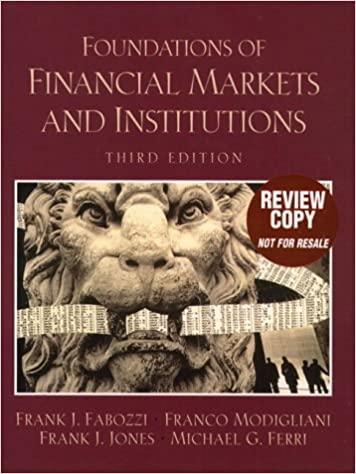Question
QUESTION 1 A mature company in the Beverage and Food Industry, with stable earnings expects to have earnings per share (EPS) of 30 AED in
QUESTION 1
A mature company in the Beverage and Food Industry, with stable earnings expects to have earnings per share (EPS) of 30 AED in the coming year and its current stock price is 280 AED. The management must decide between the following alternatives: Pay all its earnings as dividends and abandon the new investment in Dubai or Cut its dividend payout rate to 75% and implement the Dubai Project. If the second policy is followed there is a divergence in the estimation of the Return on New Investment.
(i). Pay all of its earnings as dividends. Because of the status of the company and its strength in the market, the CEO believes that cash flow from operations is sufficient to continue to reinvest in growth, though must abandon Dubai Project for next year, and decided to pay out all of its earnings to investors. Besides that, current economic conditions are weak due to the crisis, and the CEO is more willing to pay dividends than to enter a program of share buybacks. In addition, there is a favorable tax environment.
Questions:
(1) What is the dividend yield and the growth rate of the firm?
(2) Calculate the required rate of return.
(3) What is the firms P/E ratio?
(ii). Cut its dividend payout rate to 75%. On the other hand, the companys manager has negative expectations regarding the recent financial crisis and advises cutting dividends even if this is not consistent with its long-run growth in earnings. He believes that it is better to reinvest some of the earnings to open new stores in Dubai, a project that will last 2 years and hence, it is advisable to safeguard its financial reserves for future expenses. If the firm follows this program the return on investment is expected to be 17%. Suppose that the required rate of return is the same as calculated in Question (2) above.
Questions:
(4) What effect would this policy have on the companys stock price?
(5) Justify the dividend policy of the firm for both cases (i) and (ii).
(6) What would be the total return of a stockholder under conditions (ii)?
(iii). Expected return on New investment is 9% rather than 17%. Global Financial Crisis is severe and persist. The manager of the company estimates that in this case the return on the new investment will be 9% rather than 17%. Assume EPS = AED 6 and the required rate of return is unchanged.
Questions:
(7) What effect would this change have on the companys stock price?
(8) Should the company implement the new investment project and open new stores in Dubai?
(9) What do you advise the firm given the above scenarios, firms conditions, and economic situation?
(iv). Taking into consideration the markets systematic risk. Our firm has a beta factor (systematic risk) quite low, equal to 0.67. This is expected as our firm belongs to the Beverage and Food industry. The economys risk-free rate is 6% and the markets return is 10%.
Questions:
(10) Estimate the risk premium.
(11) Estimate the required rate of return using CAPM.
(12) Estimate the price of the stock under alternative (ii) using your answer to Q (11). How do you explain the difference in price found in Question 4?
(13). What should be your final estimation of the firms stock price?
Step by Step Solution
There are 3 Steps involved in it
Step: 1

Get Instant Access to Expert-Tailored Solutions
See step-by-step solutions with expert insights and AI powered tools for academic success
Step: 2

Step: 3

Ace Your Homework with AI
Get the answers you need in no time with our AI-driven, step-by-step assistance
Get Started


